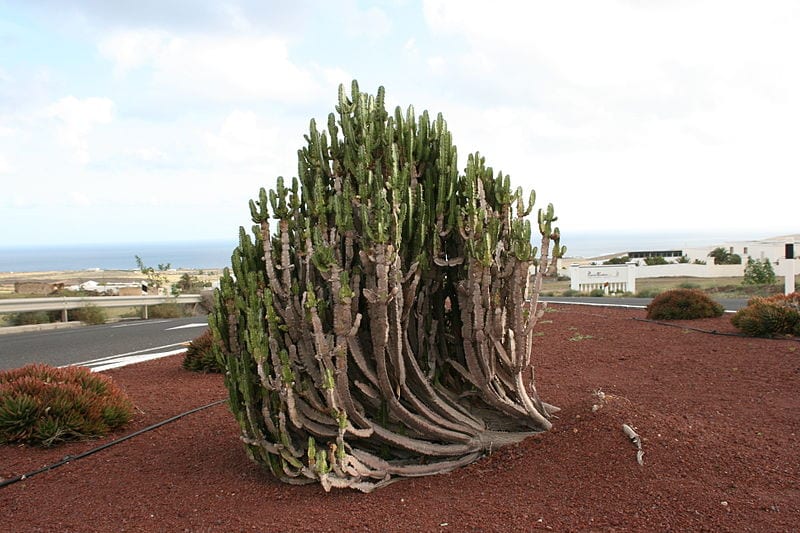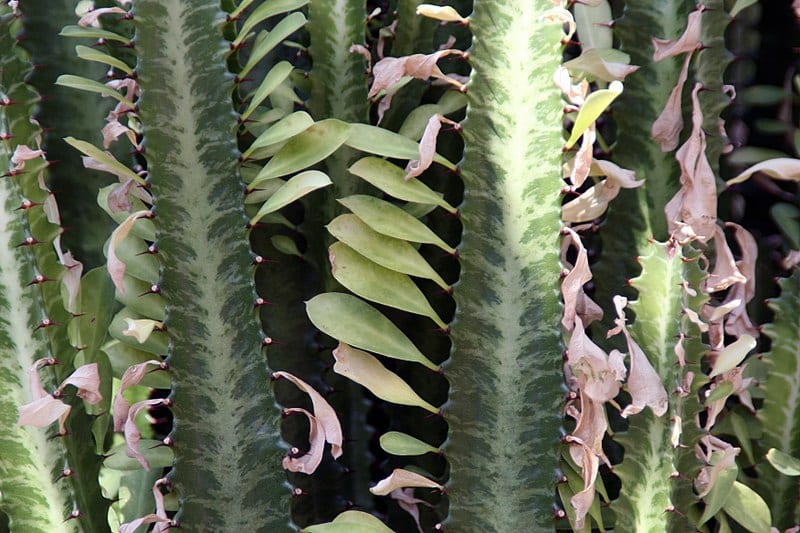
Image - Wikimedia / Frank Vincentz
Few euphoria are as popular as our protagonist, and few are those who have ever seen a truly adult specimen. The name by which it is known is Euphorbia trigona, and it is one of the succulent trees that we find on the African continent.
Despite its origin, from experience I can tell you that it is capable of withstanding enough cold and even weak frosts, but ... Have you ever wondered what care you need? Well, if so, it is time to answer that question 🙂.
How is it?

Image - Wikimedia / David J. Stang
Euphorbia trigona it is a succulent plant native to southeastern Africa, specifically from the Graboon River. It was described by Philip Miller and published in The Gardener's Dictionary 1768 the year. Its common names are African milk tree and crown.
Grows to a height of 4-5 meters, with erect stems divided into segments between 4 and 6cm in diameter. Its spines are spatulate, 2-4mm, of reddish-brown chlorine. It has leaves 3-5cm long, spatulate and terminated in a short mucron. These usually remain on the plant if the growing conditions are suitable, that is, if the climate is warm and you have a regular supply of water and compost.
Like all species of the genus, its interior contains a latex that is toxic, so you have to be especially careful if you have to prune it, change it pot or plant it in the garden.
How do you take care of yourself?
Is not difficult; in fact, it is one of the easiest highs to maintain. But if you do not have much experience or do not want to take any risk, then I recommend providing the following care:
Location

Image - Wikimedia / David E Mead
La Euphorbia trigona it is a sun loving plant, or what comes to be the same: heliophile. The problem is that many times it is grown protected from the sun, I have even seen it labeled as a »houseplant», which is a mistake. Therefore, if we get a specimen that does not know what it is to be exposed to sunlight all day, we have to get used to it little by little, following the advice that I offer you in this article.
Earth
- Garden: the land must have good drainage. In the case that it is very compact, a 50cm x 50cm planting hole will have to be made (better if it is larger) and fill it with universal growing substrate mixed with perlite in equal parts.
- Flower pot: It is not a plant that can be kept in a pot for its entire life, but during its first years it can be grown in a container with holes filled with universal growing substrate mixed with perlite, or if preferred, with pumice.
Irrigation
The frequency of irrigation will vary a lot, not a lot, as the months of the year go by. Even so, it must be borne in mind that it resists drought better than waterlogging. Then, to avoid problems we must check the humidity of the soil before watering, for example by introducing a thin wooden stick (if it comes out practically clean when it comes out, we can water it), or weighing the pot once watered and again after a few days (wet soil weighs more than dry soil, so this weight difference will help us to know as a guide).
In case of doubt, I insist, we will not water, but we will wait a couple of days or three before proceeding to give it water again. Anyway, you have to know that in summer we will water it, more or less, once or a maximum of twice a week, and the rest of the time every 15 or 20 days.
Subscriber

During spring and summer It must be paid with fertilizers for cacti and other succulents following the indications specified on the product packaging. We can also in autumn if we live in an area with a warm or mild climate.
Another option is to pay it with Blue nitrophoska, each 15 days.
Multiplication
La Euphorbia trigona multiplies by seeds (difficult) and cuttings in spring or summer. Let's see how to proceed in each case:
Seeds
What to do is:
- Fill a tray of about 10,5 cm in diameter with holes with universal culture substrate mixed with perlite in equal parts, or with vermiculite.
- Water conscientiously.
- Place the seeds on the surface, and cover them with a thin layer of substrate.
- Water, this time with a sprayer.
- Place the tray outside, in semi-shade.
If all goes well, they will germinate in 2-3 weeks.
Cuttings
It is the most used technique. You just have to cut a piece, let the wound dry in semi-shade for a week, and then plant it in a pot with a universal culture substrate mixed with 50% perlite.
To have a greater chance of success, we can water with rooting hormones, but it is not mandatory.
In a maximum month it will have emitted its own roots.
Planting or transplanting time

La Euphorbia trigona it will be planted in the garden in spring, when the risk of frost has passed. If it is in a pot, it must be transferred to a larger one every 2 years.
Pests
It can be attacked by White fly, which is well controlled with sticky yellow traps.
Rusticity
It resists weak and occasional frosts of up to -2ºC, but it is convenient that it does not drop below 0 degrees and less if he is young.
What did you think of Euphorbia trigona?
Excellent all the explanation, clear and precise. Until a week ago I had a potted one. I don't know what happened to him and he just died. I am very sorry since I was very fond of him.
I would like to know here in Santiago de Chile where I can find.
Hello Elena.
Sorry, we are in Spain and I can't tell you where they will sell in your country.
For now, you can look on eBay. There they usually sell different types of plants.
Anyway, see if someone who is there can tell you.
Greetings.